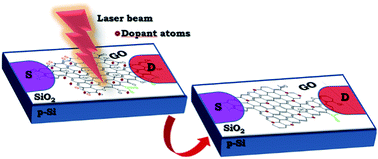In situ photo-induced chemical doping of solution-processed graphene oxide for electronic applications†
Abstract
We developed a photochemical method for the simultaneous reduction and doping of graphene oxide (GO) layers through ultraviolet laser irradiation in the presence of a dopant precursor gas. It is shown that a few seconds of irradiation is sufficient to dope the GO lattice, while the doping and reduction levels can be readily controlled upon variation of the irradiation time. Using this method, the simultaneous reduction and doping of GO with chlorine or nitrogen atoms is achieved and confirmed by Raman, FTIR and X-ray photoelectron (XPS) spectroscopy measurements. To demonstrate the potential of the approach for practical applications, the photochemical method was successfully employed for the in situ laser induced modification of prefabricated GO field effect transistors. Real time monitoring of the evolution of charge transport as a function of irradiation time reveals significant changes, a result attributed to the chemical modification of the GO lattice. The facile, rapid and room temperature nature of the photo-induced method proposed here provides unique opportunities for the cost-effective synthesis of bulk amounts of chemically modified GO for a wide range of applications spanning from transistors and sensors to transparent electrodes for lighting and photovoltaic cells.


 Please wait while we load your content...
Please wait while we load your content...